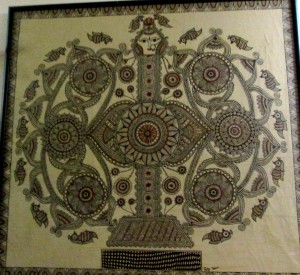Mithila Art, is a distinctive form of artwork from Janakpur and the Eastern Terai region of Nepal: the name ‘Mithila‘ is associated with the ancient ‘Mitha’ Kingdom [Videha Kingdom] — and the mythical King Miti — whose capital was Janakpur. It is also internationally important as an arts-orientated force for gender equality & women’s empowerment in Nepal and South Asia.
Ancient History & Myths:
‘In the following we see that Mithila Art is wedded to the concept of democracy from a very early period, predating by millenia the emergence of modern democracy — this background and context has special significance for Mithila Art’s most internationally renowned characteristic: women’s empowerment, itself one of the fundamental strands of modern democracy and related egalititarian values as seen through gender equality.
‘The most important reference to Mithila is in the Hindu epic Ramayana, whereby Lord Rama’s wife Sita is said to have been the princess of the land, born to King Janaka, who ruled Mithila. Other kings of Mithila during the ancient period were Bhanumath, Satghumanya, Suchi, Urjnama, Satdhwya, Kriti, Anjan, Arisnami, Srutayu, Supasyu, Suryasu, Srinjay, Sourmabi, Anena, Bhimrath, Satyarath, Upangu, Upgupt, Swagat, Snanand, Subrachya, Supraswa, Subhasn, Suchurut, Susurath, Jay, Vijay, Critu, Suny, Vith Habya, Dwati, Bahulaswa and Kriti Tirtiya.
It is said that the last king of the Janakas was of bad character. He was deposed by the public under the leadership of acharyas or learned men. Thereafter, Mithila remained without a king for hundreds of years. During this period, instead of a monarchy, a democratic system was followed under which the ruler was elected by the people and decisions taken in a collective manner …..’ read more.
Source: Wikipedia
About Mithila Art:
Mithila Art itself, which is reputed to have originated in the 7th Century CE, takes many forms; from paintings (also known as Madhubani painting) to internal and external home murals, floor paintings (known as ‘Aripan’: see below) — drawn by female Mithila artists — pottery, through to textile creations of multiple utilitarian (see quilts project below) kinds and a number of handicrafts, and music forms. It is associated at a global, as well as South Asian, level with artistic [mainly paintings and murals] and handicraft creations as a means of women’s empowerment in a context of traditional male-orientated culture (and by extension and in practice female disempowerment).
Aripan:
‘Mithila folk art is a native art drawn on the auspicious and ocussions and religious celebrations by rural Maithili women of southern Terai of Nepal and Bihar in India. It is mainly divided into two groups: floor drawings or line drawings on the ground known as Aripan … Aripans are mostly in the nature of semi-geometric floral design. Each diagram has well defined center on which an installation of a sacred pot, a plate, a basket or a seat is made for ritual purpose.
The subject matter of Aripan generally falls into five groups- I) Images of human beings, birds and animals including fish, peacocks and snakes, along with natural phenomena; ii) flower (lotus), leaves, trees and fruits; iii) Tantric symbols e.g. tools (hammer,….); iv) Images of gods and goddesses; v) Lamp, mountain, rivers etc. Figures and symbols used in the Aripans express the cosmological concept of Tantra … read more.
Source: Janakpur Handicraft Center website
Mithila Arts:
Article by Bijaya Ghimire:
 As the wedding ceremony is a special occasion in Maithili society, which is also known as “Kohabar” within the community, a separate room is set and decorated tastefully with several arts for its celebration. This painting is done in the inner as well as outer walls of the Kohabar Ghar (honeymoon house). As a popular social practice, its main motto is to increase the sexual potency and fertility of both the bride and bridegroom. This special painting is drawn on the walls of the house in three places: the Gosaighar (special room for family god), the Kohabar Ghar (honeymoon room) and Kohabar-Gharak-Koniya (corridor or outside of the Kohabar Ghar). … read more.
As the wedding ceremony is a special occasion in Maithili society, which is also known as “Kohabar” within the community, a separate room is set and decorated tastefully with several arts for its celebration. This painting is done in the inner as well as outer walls of the Kohabar Ghar (honeymoon house). As a popular social practice, its main motto is to increase the sexual potency and fertility of both the bride and bridegroom. This special painting is drawn on the walls of the house in three places: the Gosaighar (special room for family god), the Kohabar Ghar (honeymoon room) and Kohabar-Gharak-Koniya (corridor or outside of the Kohabar Ghar). … read more.Internationally renowned Mithila Artists and Artisans:
S.C. Suman: Tree of Life article in the Nepali Times:
‘For centuries, humans have been obsessed with understanding the conscious and subconscious mind. We want to determine who we are and what we’re doing in the world. Do we serve a greater purpose, or are we destined to merely perambulate life but not fully understand? And what is our connection to the universe? These are the breed of questions that are evoked when experiencing SC Suman’s Mithila Cosmos: Perambulating the Tree of Life … read more.


